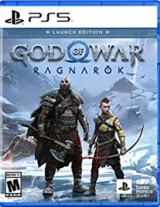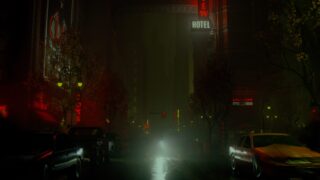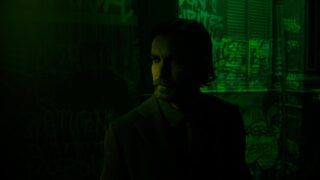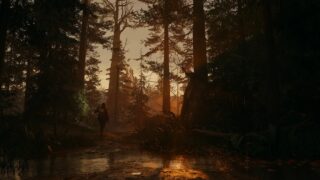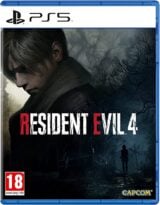Alan Wake 2 interview: ‘True Detective was definitely on our mind’
Remedy explains how the HBO show and ’90s movies are key influences for the sequel

Some 13 years after Alan Wake arrived on the Xbox 360, its sequel is finally due for release on October 17.
Over the years fans of the original have been treated to the likes of spin-off Alan Wake’s American Nightmare, some Alan Wake themed DLC in Control and a remaster of the original game, but a ‘proper’ sequel has always been the primary wish and it’s finally nearly here.
After being treated to a 30-minute demo during which we saw the game in action, we sat down with co-director Kyle Rowley and principal narrative designer Molly Maloney to talk about how Alan Wake 2 differs from its predecessor, and how they feel about the recent announcement that Spider-Man 2 will be released just three days later.
They also explained how the character-switching mechanic and discussed the Mind Place, the interesting hub area where players controlling new character Saga can piece together the ongoing investigation.
Remedy feels like such a well-oiled machine now, when it comes to making these sorts of narrative single-player games. Could you give us an idea of how long it’s taken to put Alan Wake 2 together, because externally, it feels like it’s come together really quickly? How many concepts were ready to pick up off the shelf?
Kyle Rowley: Obviously, we did Alan Wake 1, and straight after that we really wanted to do Alan Wake 2. Unfortunately, it didn’t work out and we ended up taking all the ideas that we had for that – I think we showed a video a long time about what a potential Alan Wake 2 would look like – and a lot of the ideas for that went into Alan Wake’s American Nightmare.
And then, basically, every game since then has started off almost as Alan Wake 2, so we’ve had many different ideas over the years about what it could be.
But I think that we learned a lot making Quantum Break about how we can do interactive storytelling, we learned a lot in Control about how players like to consume content, how much agency we want to give. So I feel like, actually, the concept we’ve ended up with now is definitely the best version of what Alan Wake 2 could be.
When I joined the project, which was in 2019, it was just me and an executive producer working on the project, Sam was writing Control. But that’s when we started to ideate. There were a lot of ideas that we had through the years on what could it potentially be, that’s when we started to ideate on ideas like ‘okay, how can we improve on Alan Wake 1’. That’s where the survival horror genre shift started to occur.
We were looking at issues that we felt were in the first game, such as a bit of a dissonance between what the story was trying to do versus what the gameplay was trying to kind of push you towards. So we wanted to kind of counterbalance that. So yeah, it’s kind of been a long process, so I would say this concept really kickstarted in 2019 when I came back to Remedy from where I was before.

I think the biggest question that everyone’s asking at the moment is how exactly does the character switching work?
Molly Maloney: So the way it works is, of course, we’re debuting Saga right now and the focus is on her, we’re going to talk about Alan more later in the summer.
But basically the structure of the game is you open up with Saga. She arrives in Bright Falls, she’s investigating these ritualistic killings.
As you can imagine things spiral from there, she gets in over her head a little bit and at a certain point you unlock Alan. And then after that point, you can switch between the two paths, the two stories.
They are unique stories to both characters, they highlight different mechanics, they have different tones. Alan represents approximately 50% of the experience.
And then but a lot of the reasoning behind this is a couple of things. One, Alan has been involved in this for 13 years, he has his own perspective. Saga, as a newcomer, provides a very different perspective.
Both sides of that story have their own tone, and that kind of provides a refresh.
KR: Yeah, basically, we want to make sure that if you’re overwhelmed with the fear – you know, we don’t want to create one-note horror all the time, but I think part of the Alan Wake IP is definitely quirky characters, small town Americana, daytime scenes.
So one of the parts of that was to allow the player to decide ‘okay, Alan’s stuff is a bit overwhelming, maybe I’ll go play in a daytime sequence as Saga. So it’s giving the player a bit of choice about how they experience those two stories.
MM: With Alan it’s understandably a darker side, he’s in the dark place. So the approach to switching is you can play it in whatever order you prefer. It allows you to kind of pace it in the way that you’d like. But when it comes to the narrative, the narrative was actually designed to do that.
So it involved a lot of iteration, playing it over and over again, making sure that, if I play a lot of Saga and then jump to Alan, is that rewarding? If I [alternate] between them, how does that feel?
So no matter how you play, you kind of get different context and different rewards for doing that. And then you will hit a point where, basically…
KR: You’re forced to go to a character. It’s like, you start off linear, we introduce Saga, we introduce Alan, we introduce their concepts and at that point, it’s kind of like two parallel stories.
It’s an overarching story that connects them both, but they’re two parallel ones so I can decide which I order I play in, until the point where it’s like ‘okay, now you have to go play here’ and then we conclude basically.
MM: So once you get to a certain revelatory moment, basically, then we put it back in our control.
I’m guessing, narratively, bringing in Saga sounds like a good way to introduce players who perhaps have forgotten the events of the first game, or didn’t play it at all?
MM: Yeah. And I think, of course, it’s a fantastic POV for players who have never experienced Alan Wake, but also even fans of the franchise – it’s been 13 years, so it’s really nice to have that.
But also, a core theme of the game is duality – two worlds, two characters, fact and fiction. So Saga and Alan have very unique perspectives on the situation, and I actually think agnostic to her being an excellent entry point, she also provides really valuable context as to what’s going on, whereas Alan is very much immersed in what’s going on.
What I found really interesting was the Mind Place. I wondered how deep that is mechanically? You mentioned during the demo that you guys spent 18 months fleshing that out and changing things and trying stuff.
KR: Our starting point with almost all our games is, you know, we have a story and we have a character, and then we try and build both the narrative arcs for that character and the journey they go through from a narrative side, but also from a player experience perspective.
So, for example, with Saga, she’s an FBI agent, she’s a profiler, she’s coming to investigate things inside the Pacific Northwest, so we wanted to make sure that we built game mechanics that supported that power fantasy.
So we wanted to basically allow the player to investigate crime scenes, pick up clues, but we wanted that to be an actual gameplay system, where the player was interacting with themselves.
So then we were like, okay, how can we make that? We don’t want them to be walking back to an office or something, so how can we make it meaningfully interesting? So that’s where this idea of a Mind Palace technique came from.
And because with the new hardware we have access to SSD drives so we can load stuff super fast, by the touch of a button we could take you to this new place. And then we could start adding gameplay mechanics which directly connect to her power fantasy, like the case board, and the profiling.
And for sure, as Molly can attest to, we have been through many iterations on how that could actually work.
[Molly grimaces]
I’ve seen three people talk about this now and all three grimace when you talk about it! It seems it was a painful process to get to where you are.
MM: [laughs] Well, it’s not been painful, it’s just iterative, right? Where there’s a fantasy rite of solving a case – placing these clues and feeling smart doing so – but you also want to strike a good balance, right?

Was it a case of finding just the right amount of autonomy to give the player so they don’t get lost?
MM: Yeah. The case board is one of the mechanics that I’ve been responsible for and we’ve gone through so much playtesting where it’s like ‘this gives you a lot of freedom, but you can actually sometimes get bogged down or overwhelmed’.
There’s a lot of clues on that board, so it’s like, how do we give you that exciting fantasy of being an FBI agent, but also keep the pace going? We’re a narrative driven project – we want to make sure that you don’t get bogged down and lose the excitement of what’s going on.
So yeah, the case board – I grimace because yes, we’ve gone through many versions of it, but we’re actually really happy with how it’s landing now. But also on top of that in the Mind Place you’ve got profiling, which is another key part of Saga’s mechanics, and it’s really cool too.
It’s like this visual presentation of her, like digging into key people of interest’s heads and pulling out information that unlocks new gameplay topics as well as clues, and then there’s a ton of other cool stuff you can do in there.
KR: Manuscripts are logged there, we upgrade our weapons there, we have collectibles, you find them stored there, there’s a few maps there, it’s like a 3D menu, effectively.
But one of the important things for this game, because we’re very narrative-driven and atmosphere and emotion is important, that’s why we wanted to lean a bit more on something physical that’s in the world, rather than just a 2D UI.
I also saw quite a few dialogue options in the demo too, is that something that’s kind of sprinkled throughout?
MM: Chatting with people, I think, is really important – you know, one of the standout things about the first Alan Wake was the quirky and interesting characters that you meet, and we wanted to give you more opportunities to do that. Obviously, there were [conversation] topics in Control and I think we had a lot of learnings from that.
When the writing team was working on screenplays, narrative design was a part of that so we got to sit in on the room, and so we’d come up with “well, what would you want to ask Casey about? How could we tell the player more about these characters in these moments, but also provide really valuable information?”
There’s a lot going on in the story, so being able to talk to people and ask questions that are on your mind, I think is really rewarding.

And that’s where the Case Board is very important, because in addition to getting Saga’s perspective, the player is the one actively doing it.
They’re pressing buttons, saying things – that was our approach for the conversations, that the player has some agency over how they consume that content, the order in which they do it, so you’re more focused on what you consume and I think we really wanted to find gameplay-driven ways to tell this story in addition to the more traditional linear formats we get like cinematics.
MM: Yeah, you absorb information far better, I think, through interactivity and there’s a lot of twists and turns in the story, as I think you could imagine.
So, is it the case that eventually the player will get to all of the content, or is it a case that you find a lot of value in replaying the story again and doing things a different way?
MM: I mean, it’s a tight rope walk, right? We want to make sure the players end up with the minimum viable understanding and make sure that this all makes sense in a way that is meaningful.
But exploration was a key pillar of this game. And that’s not only physical exploration of spaces, but it’s also, you know, if you don’t talk to Casey in that moment, you don’t necessarily get to experience that conversation later. It’s there, and if you want to avail yourself of it, you certainly can.
KR: The story has kind of been written in a layered way in the sense that on the surface level, on the critical path, you’ll get a good understanding of what’s happened.
But on subsequent playthroughs, there’ll be things that you discover which maybe slightly change your perspective, like the order in which you play Alan’s experience and Saga’s experience, you will get slightly different perspectives on the story, which can give you a slightly different perspective into the story as a whole. So yeah, we wanted to basically allow players to replay through the game.
So how do the two characters work with the Mind Palace? Does Alan have one or do they both contribute to the same one?
KR: So obviously, we wanted to create one game, so we didn’t to basically create two different experiences. So Alan does have an equivalent to what Saga has, but we’re not going to go into too much detail about how it works right now, because we’re going to talk about Alan later.
But yeah, we wanted to make sure it felt like it’s not playing two separate games so mechanically, and idea and control-wise, players don’t have to relearn things every time they’re switching characters.
So it’s a similar experience.
KR: Yeah, but under a different context.
The first game was compared endlessly to things like Stephen King novels and Twin Peaks. Is there a specific film or literary influence for this game?
MM: I’d say True Detective comes up a lot.
KR: Yeah. I mean, we have many different references, and it’s interesting because me and Sam and [art director] Janne [Pulkkinen] and the narrative team, obviously we all have our favourite different media that we like to consume.
But when we were thinking about introducing a new character and we knew that we wanted to have FBI agents investigating these ritualistic serial killings, there were some certain TV shows and movies that we were definitely like “okay, they did this really well”.
So the slow burn nature and the kind of buddy cop scenario that True Detective season one had is there, and those kind of ritualistic serial killings were definitely on our mind.
But then, also, just from an art direction perspective, we’re very influenced, especially on Sega’s experience, by the Coen brothers and Fargo. A lot of our art direction is grounded a bit more on the ‘90s side, so things like Se7en are things we’ve talked about quite a lot.
And then, on the game side, obviously we all love Silent Hill and Resident Evil, so we drew some influences from there, but a lot of our influences come from pop culture rather than necessarily games, specifically.
There was quite a reaction to you guys making Alan Wake II a digital-only release. What advantages does that give you on the development side? For example, in terms of when you need to finish the game and submit it.
KR: Yeah, the production process of making discs is quite long, so it means that you have to submit to certification and stuff quite far in advance.
And basically, from our side as developers, the more time we get to work on polishing and fixing bugs or whatever, the better for us when creating a very good experience.
MM: It also keeps the price point down, which is good for the players, but more importantly I think the dev team has put a lot of work into this, and it’s really going to allow us to have the best quality product we can.
Those extra couple of months are going to make a meaningful difference in getting all of this polished and, really, we want to take the landing on this thing and that was the right choice for us.
I think a lot of the reaction from fans online was probably around the issue of preservation – the original game was delisted in 2017 for more than a year because of expired music licences. Have you taken any measures to ensure that doesn’t happen with this game?
We’ve tried to actively actually stay away from licensed music in general. We actually have a bunch of… we’re not talking about it too much right now, but we’ve done a lot of interesting things with music in this game that we’ve never done on a previous Remedy game, which does help us a bit with that situation.
And obviously from our perspective, we definitely don’t want the game to be delisted or anything like that.
Obviously, Remedy’s games tend to be interlinked – for example, Alan Wake being in Control DLC. How far do you go with that in this game?
MM: Alan Wake 2 is part of the Remedy connected universe but, that said, it is its own standalone product. It’s very important for us that you shouldn’t have to do homework to enjoy a video game.
So I think that there’s going to be a lot of exciting moments for people who are aware of the other games.
So it’s always an additive thing from your perspective, rather than something like a Marvel Cinematic Universe.
MM: Exactly. You don’t want to build a prison of your own devising, but at the same time, we have a really exciting world and we’re happy to set this game in it.
KR: Yeah, if people are invested in our games, then I think that additional layer is slightly below the surface of the core… you know, it’s a lot of work making a video game just in general, so we really want to focus on making that game as good as it can be.
Those connection points to other Remedy games are definitely things that we think about, but it’s not our primary motivation for making this game, it’s kind of its own thing.

You’ve said that this is your first survival horror game. What makes the delineation between the first game and that, because obviously there was some horror elements in that first game? The first game was also known for, like you mentioned, lighthearted moments as well, it was actually quite funny in places. Have you kept that sort of thing in?
MM: Well, I would say the first game was more of an action-oriented game and I think that that was because of the tools that we had available to us at the time and the story that we were looking to make at that time.
It’s been 13 years, and not only has Remedy evolved and changed, but the industry has evolved and changed as well. We have a lot more technical capability than we had at that time.
Kyle, you’re very good at talking about that, but I will say from my perspective, this is exactly the story that we wanted to portray, and when we looked at the story, we were like “well, we just made a horror game”. [laughs] So we’ve been working on making that the best horror game it can be.
That said, the quirkiness of the original is a cornerstone of the IP, and I like to say you can’t cry if you don’t laugh – you know, you need that duality, which is one of our core themes. So there’s definitely room for a lot of levity in this film. Uh, in this movie.
KR: In this game?
[both laugh]
MM: Yes, in this game! But yes, basically, what is a Remedy survival horror game? It’s an emphasis on narrative, it’s tension, it’s tone.
There’s so much about fear – it’s not about fear, it’s the anticipation of being afraid that’s important. And then it’s exploration. So that’s kind of how I would distil it.
KR: Yeah, I think Molly alluded to it, but we wanted to make sure that the story we were telling was very much aligned with the game play.
You know, we can slow down the character so you’re walking or slow, we have much more focus on environmental storytelling, as you can see in the demo, we’ve got quite a lot of detail.
Places should feel like they belong, and I think that’s something that going to a survival horror game gives us over something like Control where, you know, you’re zipping around very fast, you lose some of that environmental storytelling and I think that’s very important for a narrative game.
So those things just connected in a nice way and I think this makes sense for us.
A lot of fans will desperately want this game to do well commercially – the first game was critically very well received, but didn’t find a gigantic audience. You’ve announced your release date now and you’re slap bang in between some very, very big games, as I’m sure you’re aware. Is that a surprise to you? I’m sure you did your homework!
KR: You know, we already knew that Assassin’s Creed Mirage was going to be in the fall, we knew that Sony had already said that Spiderman 2 was going to be in the fall, so we kind of already knew that they would be around us.
We feel that we’re proud of the game that we built, and I think the people who resonate with that kind of game… whether they buy Alan Wake 2 or Spider-Man 2 isn’t really what we’re thinking about. We just want to put forward our game and present it to the players.
You know, one is an adventure game, one is a horror game.
And I suppose the fact you aren’t going to have boxes on store shelves probably helps in that issue too?
KR: Yeah, in terms of retail space, for sure. You know, no matter when you release a game, there could always be something else that’s coming out, right? You just can’t worry about it too much.
